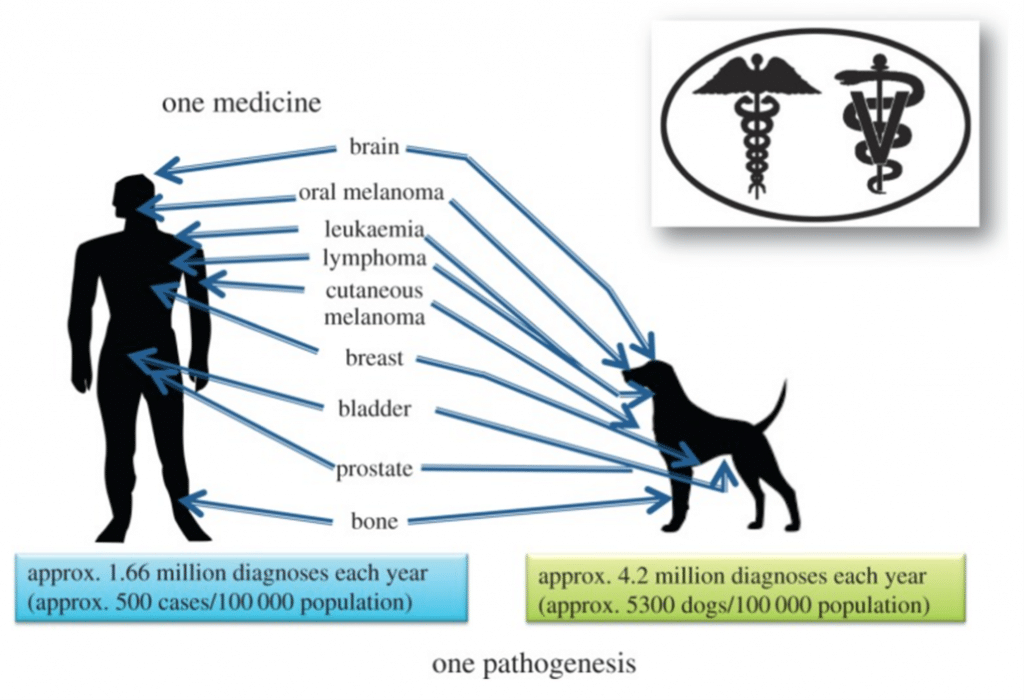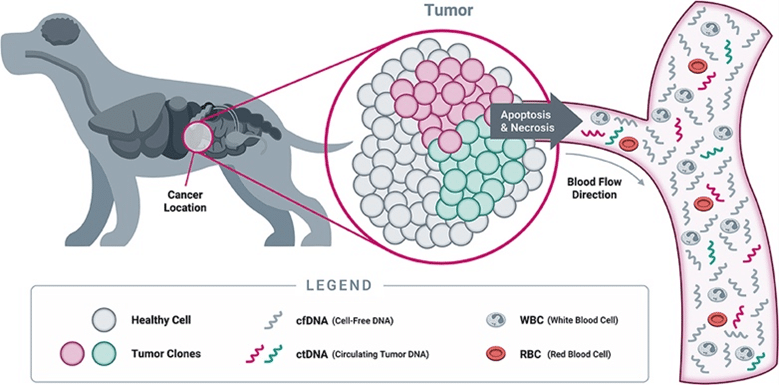
Liquid Biopsy in Veterinary Medicine
Liquid biopsy, a new diagnostic tool first developed in human medicine, is positioned to revolutionize the way veterinarians diagnose and treat pets with cancer. Dogs get cancers just like humans (Fig 1).
Analyzing Diseases in Canines
The most common cause of death in adult dogs is cancer. It is estimated that about 4-6 million dogs will be diagnosed with cancer every year in the US (1).
Early detection and diagnosis, disease monitoring and targeted treatments can all improve survival rates of pet dogs with cancer. Similar to human medicine (BioChain: A Tale of Two Biopsies), the gold standard of taking a tissue biopsy or a fine needle aspirate can be very invasive and stressful for both pet owners and pets themselves. Other drawbacks are the anatomical location may not be accessible or the material from the tissue sampling is of poor quality or insufficient quantity for testing. This is where liquid biopsy can alleviate these hurdles. Through a simple collection of body fluids such as a blood draw, a veterinarian can send the sample to a diagnostic lab to test whether a patient’s sample contains specific biomarkers that indicate presence of disease.

What is Liquid Biopsy?
Liquid biopsy is based on the fact that as normal cells grow and die, they release their genetic material into the blood stream or other body fluids. These small <200bp fragments of DNA are called cell free DNA (cfDNA). Similarly, this is also true with cancer cells. As tumor cells go through their life cycle, a steady stream of these circulating tumor DNA (BioChain), or ctDNA, is released and can also be detected in body fluids (Fig 2).
It has been shown that the concentrations of ctDNA correlates with disease severity and prognosis (3). Recently, Prouteau et al. have been able to detect tumor specific mutations using droplet digital PCR technology in the cfDNA in plasma from dogs diagnosed with 3 common types of canine cancers (4). The authors reported that in a cohort of 45 dogs diagnosed with histiocytic cancer, 23 patients had tumors containing hotspot mutations in the gene PTPN11. Among those same 23 patients, they were able to detect the same mutation in the plasma of 21 (91.3%) dogs. Furthermore, they also reported tumor specific copy number variants and chromosomal rearrangements in the plasma of dogs diagnosed with oral malignant melanoma or multicentric lymphoma (4).

BioChain's Custom Solutions
Isolating cfDNA from body fluids is no longer difficult and cumbersome. Utilizing magnetic bead-based technology such as BioChain’s cfPure Cell Free DNA Extraction kit, researchers are able to isolate cfDNA from <1mL to >10 mL plasma or serum. It is now cost effective and automation friendly. This and other advances can help drive liquid biopsy assays to become routine tests done at a pet dog’s annual checkup or for cancer diagnosis and treatment monitoring. In fact, with the recent FDA approval of the human liquid biopsy assay FoundationOne Liquid CDx from Foundation Medicine (5) and the launch of PetDx’s OncoK9, a multi-cancer early detection test for dogs, the wide acceptance and implementation of liquid biopsies for cancer detection and diagnosis and targeted treatment in the veterinary world is not far from the horizon.
Here at BioChain, we strive to provide researchers the best tools to make these discoveries. Our line of liquid biopsy products, such as the cfPure and cfPure V2 Cell Free DNA Extraction kit, cfPure DNA Free Plasma and now the Human Plasma cfDNA Reference Control and Standard (Cat number Z2121001), allow researchers to further advance cancer research in both human and veterinary medicine.
References
- Schiffman JD, Breen M. Comparative oncology: what dogs and other species can teach us about humans with cancer. Philos Trans R Soc Lond B Biol Sci. 2015;370(1673).
- Chibuk J, Flory A, Kruglyak KM, Leibman N, Nahama A, Dharajiya N, et al. Horizons in Veterinary Precision Oncology: Fundamentals of Cancer Genomics and Applications of Liquid Biopsy for the Detection, Characterization, and Management of Cancer in Dogs. Front Vet Sci. 2021;8:664718.
- Schwarzenbach H, Hoon DS, Pantel K. Cell-free nucleic acids as biomarkers in cancer patients. Nat Rev Cancer. 2011;11(6):426-37.
- Prouteau A, Denis JA, De Fornel P, Cadieu E, Derrien T, Kergal C, et al. Circulating tumor DNA is detectable in canine histiocytic sarcoma, oral malignant melanoma, and multicentric lymphoma. Sci Rep. 2021;11(1):877.
- Woodhouse R, Li M, Hughes J, Delfosse D, Skoletsky J, Ma P, et al. Clinical and analytical validation of FoundationOne Liquid CDx, a novel 324-Gene cfDNA-based comprehensive genomic profiling assay for cancers of solid tumor origin. PLoS One. 2020;15(9):e0237802.
Author
Shukmei Wong has over 15 years of experience in the science industry. She has contributed to research in development of vaccines for HIV and researching the genomic alterations of various human and canine cancers utilizing next generation sequencing technology. In her free time Shukmei enjoys crocheting and spending time with her family along with her furry and feathered army of 1 dog, 2 cats, 3 parakeets, and 6 chickens.


